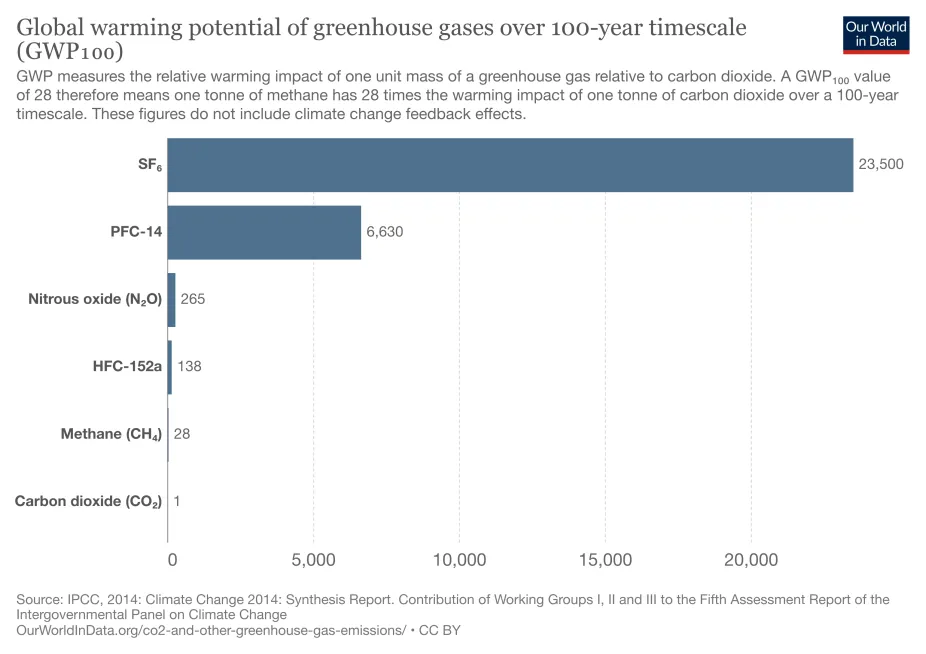Some Greenhouse Gases Are Stronger than Others
Have you ever worn a t-shirt, a long sleeved thermal undershirt, a hot scratchy sweater and a heavy coat on a warm summer day? All those extra layers could cause you to feel overheated. Our planet is also wrapped in outer layers called the atmosphere, which is is full of gases. Most of them are nitrogen and oxygen which have no impact on the climate. In the right amounts, greenhouse gases, like carbon dioxide, methane, and nitrous oxide, are helpful, rather than harmful, because they can help regulate the temperature of the planet.
The problem is that human activity has led to a dramatic increase of greenhouse gases in the atmosphere and, like you wearing all of those layers, the Earth becomes overheated.
Not all greenhouse gases have the same heat-trapping abilities. And they don’t all stay in the atmosphere for the same amount of time. So, some greenhouse gases are stronger than others.

Some greenhouse gases cause more warming than others. The chart above shows the relative impact of six greenhouse gases. Compared with carbon dioxide, sulfur hexafluoride (SF6) causes 23,500 times as much warming and tetrafluoromethane (PFC-14), which is used as a refrigerant and in electronics, causes 6,630 times as much warming. Nitrous oxide (N₂O) causes 265 times as much warming and methane causes 28 times as much warming. HFC-152a, which is used as a refrigerant and in aerosol sprays causes 128 times as much warming.
Chart by Our World in Data with data from IPCC (2014)
Carbon Dioxide (CO2)
Carbon dioxide (CO2) is a gas that is naturally-occurring and generated by human and animal respiration that is made of one carbon atom and two oxygen atoms. The right amount of CO2 is important so that people, animals, and plants can breathe.
How strong is it?
CO2 has a low heat-trapping ability compared to other greenhouse gases, but there is now so much of it in the atmosphere that it causes much of climate warming. CO2 accounts for a vast 82% of greenhouse gases emissions. CO2 molecules remain in the atmosphere for a long time - after 100 years, 40% of the CO2 that is in our atmosphere today will still be present.
What can we do to reduce CO2 emissions?
Besides reducing our use of fossil fuels, we use carbon-negative technology, such as using biochar, a charcoal-like fertilizer that keeps excess carbon underground. Some companies are investigating other options, such as capturing carbon from the air.
Methane
Methane is a gas that is generated from human and animal activity, as well as from the Earth itself. Natural gas, human and animal activity (particularly the digestive habits of cattle), and waste are major sources of methane.
How strong is it?
On its own, methane is 30 times stronger than CO2. It contributes between 10-25% of global warming and though it remains in the atmosphere for less time than CO2 does (about 10 years vs. 100), methane eventually turns into more CO2.
What can we do to reduce methane emissions?
We can cut back on the amount of meat that we eat and use more energy-efficient sources for power and transportation. Experts are also working to detect and remedy methane leaks.
Nitrous oxide
When most people think nitrous oxide, they think of the “laughing gas” that dentists give their patients before tearing into their teeth. Nitrous oxide is a naturally-occurring gas that is part of the nitrogen cycle, which helps plants grow. Though it is found naturally in our atmosphere, fertilizer and fuel combustion are major sources of nitrous oxide overproduction.
How strong is it?
Even though nitrous oxide only makes up 6% of greenhouse gas emissions, nitrous oxide is 300 times stronger than CO2. It takes 114 years to break down.
What can we do about it?
Farmers can change their practices to use more eco-friendly fertilizers, and everybody can make efforts to find alternate means of transportation.
Fluorinated gases
Fluorinated gases are human-made gases that are often used in refrigerants, air conditioners, foams, and aerosols, like haircare products or certain cleaning products.
How strong are they?
Fluorinated gases may only account for 3% of greenhouse gas emissions, but they are 23,000 times stronger than CO2. They pose a threat to the atmosphere particularly because they are not a natural component of it. Fortunately, there are simple changes humans can make to reduce the impact of fluorinated gases on the Earth.
What can we do about it?
We can use fans instead of air conditioners. On a hot summer day, you can even try swimming in a natural body of water to cool off and enjoy nature! You can choose products that do not come in aerosol cans. Even shaving cream and air fresheners are available in more eco-friendly forms. Lastly, you can write letters to government agencies and officials and businesses asking for them to reduce or discontinue the use of fluorinated gases in consumer products.
Conclusion
Remember that idea of wearing many layers on a summer day? Our Earth is able to maintain its temperature with the right balance of naturally-found greenhouse gases, but when we add too much of them, the heat gets trapped. Even though CO2 comprises 80% of the greenhouse gases in our atmosphere, it’s like long-sleeved thermal undershirt that might make you feel a little too warm on a hot day, while nitrous oxide is more like an uncomfortable sweater, and fluorinated gases are like that sweltering coat. If the levels of nitrous oxide and fluorinated gases continue to increase, we could be in serious trouble because they are so much stronger than CO2 and methane. Fortunately, we can make efforts to help our planet stay cool, because, unlike us, the Earth can’t shed those extra layers.